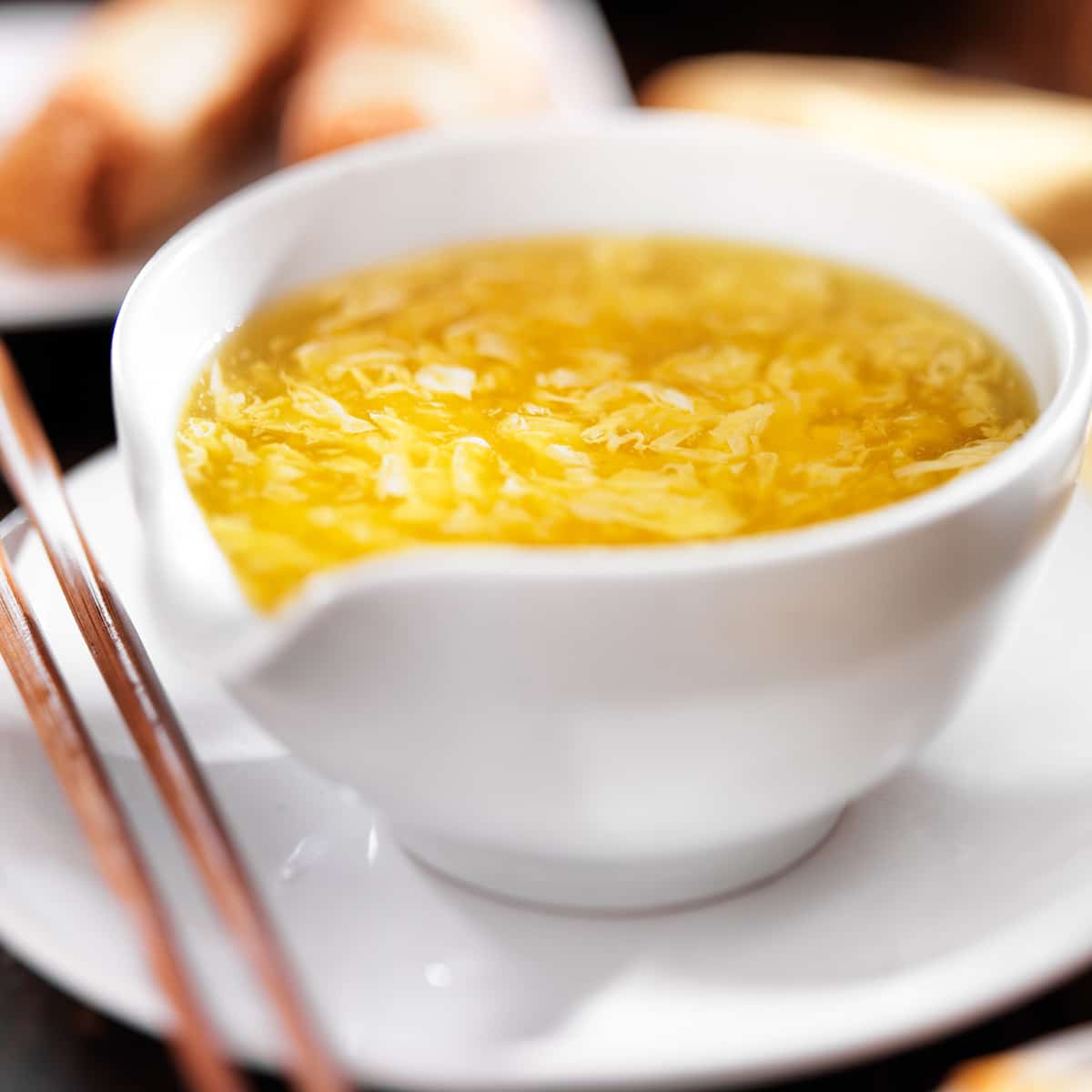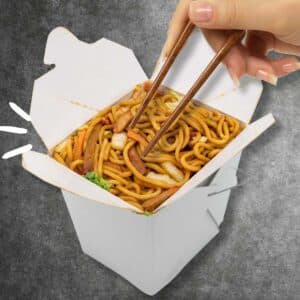The most fulfilling and filling way to begin a new day is to sip on hot egg drop soup. As an excellent starter dish, it is a favorite of many Asian restaurants.
The good news is that it is also among the most simple and quick dishes to prepare. In addition to its outstanding taste and ease of preparation, it's easy to go overboard with it, and the leftovers are bound to end up in the fridge.
Can you reheat egg drop soup? The short answer is yes. Reheating egg drop soup is possible, but you should proceed with caution. It is easy to overcook soup that has already been prepared. The best way to reheat them is to keep the stove on medium-low heat and bring it to simmer until the soup is hot.

What is egg drop soup anyway?
As a starting point, let's find out what egg drop soup is. Besides, not everyone knows what the dish is called or understands it.
A distinct texture and appearance are evident – the soup has a thick, rich consistency and flecks of egg that provide a distinct visual difference.
It traces its roots back to Chinese cuisine. The chicken stock base provides an intensely savory taste. Further enriching its flavor profile is accomplished by adding ingredients, including ginger, garlic, pepper, and green onions, and finally completing the dish with soy sauce and sesame oil.
It should come as no surprise that raw eggs are the highlight of this recipe. It is vital to avoid overcooking or undercooking the eggs. The opposite is true; eggs can become rubbery when the temperature is too hot. Aside from that, the results will be watery if you don't heat the broth properly before adding eggs.

Can you reheat egg drop soup?
You can reheat egg drop soup without losing the consistency or taste. There is, however, a time commitment involved. If you bring the soup back to a boil too quickly, it will lose its texture and flavor from being overcooked. Rubbery eggs may result.
The best option to reheat egg drop soup on the stovetop is to leave it simmering for at least ten minutes. It's a good way to keep track of how the soup cooks.
Ensure that the pot is simmering gently at medium-low heat and stir periodically until hot. The soup should be ready to eat after about 10-15 minutes.
To understand the core question for this guide, you need to know that raw eggs react differently when heat is applied; in essence, raw eggs serve as an alternative "noodle."
Despite its simplicity, it boasts a great deal of flavor and is favorite comfort food of many. To make it even more delicious, it should be creamy and light at the same time. It is only possible to achieve the perfect texture by carefully preparing the egg drop soup.
Read:
How to reheat egg drop soup
Cooking soup in bulk and storing leftovers to reheat over the next few days is a cost-effective way to feed a family. According to USDA guidelines, generally, the soup will last three to four days in the refrigerator.
What happens when you don't finish the bowl? You're not alone. Let's go over how to reheat egg drop soup.
The following are two popular methods to re-warm the soup.
Using the stovetop (best method):
It isn't complicated to reheat soup; it simply involves getting it hot enough to meet food safety standards and make your taste buds happy.
Step 1 Pick the right stovetop pot.
Use a high side pot that can handle stirring without spilling over the sides whenever possible. If the soup overflows, pour it into a larger vessel.
Step 2 Adjust the heat
Reduce the heat to medium-low and bring to simmer.
Step 3 Bring the stock to a simmer
It's a good idea to stir periodically while it simmers so the heat is distributed evenly. As you wait for this to heat up, you may whisk your eggs in another bowl if you plan to add fresh eggs (this is optional).
Step 4 Slowly stir in the eggs (optional)
If your stock has already reached the simmering point, begin stirring it with a whisk or fork in a slow whirlpool motion. Drizzle the fresh eggs slowly into the broth while stirring, and you'll see magical ribbons appear. Turn off the heat.
Step 5 Check the food temperature.
Simmering happens between 180° and 190°F and is a gentler method than boiling. Smaller bubbles burst out of the water instead of violent ones. The trick to maintaining a simmer is to monitor it closely since, with heat increasing, boiling can occur very quickly.
When using a food thermometer, stick it in the soup, but avoid touching the bottom or the sides. USDA guidelines suggest that the minimum temperature for soup is 165°F.
Step 6 Remove soup from the heat
After you have turned off the burner, take the pot off the stove; the metal will continue to be hot after turning off the heat. Immediately transfer the soup to a serving bowl and allow it to sit for a moment before serving. Sprinkle with extra green onions, if desired.
When using the Microwave to reheat:
Step 1
Take out the soup from the fridge and pour it into a circular glass container that you can heat in a microwave, not one made of plastic.
Step 2
Set the microwave at a medium power level (50%). This video will show you how to set the power in the microwave.
Step 3
Set the timer for 30 seconds and press "Start" to begin the microwaving. Following the initial heating, stir, then warm in 15-second increments, being careful not to overheat. A vital step is to stir your food. By stirring, you can avoid those undesirable cold spots.
Sidenote:
Food surfaces are heated rapidly in microwaves, but they cannot expel the heat fast enough to reach the center of your food. So, what happens? Food can develop hot spots on the surface despite being cold inside. Playing with food is one way to prevent this, obviously strategically. "Ensure that the food is evenly distributed by stirring or agitating it during the microwave process."Step 4
Check to ensure that enough heat is being imparted to the liquid. Continue microwaving for 15 more seconds if it is still cool or a bit warm.
Step 5
After reaching your ideal temperature, you can remove it from the microwave, let it stand for a minute, and immediately serve once it's cool enough to handle.
Word of Caution:
You can consider eggs as versatile foods. Ideally, you shouldn't heat soups beyond a simmering temperature, so keep them low. By contrast, high temperatures can result in egg ribbons becoming rubbery. You will lose the flavor by exposing the eggs to sudden heat and the springy texture.How long can egg drop soup last in the fridge?
When it comes to soup, you should only keep it in the fridge for three to four days if it lasts that long. Store the soup in an airtight container.
How to store it
Storing just the broth only works best, and you can add the eggs and garnishes at the last minute if you reheat the broth. For your convenience, the soup (broth and eggs) can also be stored in the refrigerator.
Most foods are best eaten immediately after preparation. Occasionally, there may be situations in which this is not possible. Perhaps, you ordered too much food because you think you are hungry. The portions may have gotten out of hand, and you made an overabundance.
Do not stress. Egg drop soup stores well in the fridge. Cooling is a crucial step in storing soup properly. When the soup is piping hot, it would be a big mistake to place it in the refrigerator.
Although it may seem insignificant, doing so can result in rapid cooling – which is detrimental to food quality.
Make sure to follow these steps:
- Cool the soup to room temperature before storing.
- Put any leftover soup in containers that can be sealed airtight.
- Put the container in the refrigerator.
Can you freeze egg drop soup?
You can freeze the broth in egg drop soup, but you shouldn't do so once the eggs are mixed in. If you do so, the eggs will become rubbery, resulting in a less creamy consistency. You can freeze the stock for up to six months and add fresh eggs when you reheat it.
To freeze egg drop soup, follow these steps:
- Pass the soup through a fine-mesh sieve (after adding all the eggs).
- Fill a freezer bag with the broth and snip off any excess air.
- Place the freezer bag in the freezer, flat side down, and consume it within six months.
You can also freeze broth in ice cube trays for portion control. Transfer the cubes into a freezer bag for easy storage after the cubes are frozen.
How to defrost
Generally, you can let the soup-base thaw overnight in the refrigerator after being taken out of the freezer. Alternatively, you can unfreeze the broth in the microwave or a saucepan. Reheat the soup over low heat until it has melted. If the broth becomes stuck in the container, saturate the base of the container with hot water.
Here's why you shouldn't freeze egg drop soup
According to USDA, the soup will stay fresh in the refrigerator for about three to four days. If you intend to keep it for an extended period, it might be tempting to stick it in the freezer — but hold off on that.
The freezing process could irreversibly deteriorate the texture, rendering your leftovers unrecognizable when reheating.
The American Egg Board reports that egg yolks freeze poorly due to their gelatinous composition, leaving a thick, rubbery texture when reheated.
Eggs and broth are the key ingredients in this soup, which means freezing them leads to unpleasant results.
What to do instead? Is there an alternative?
Of course, there is. However, it doesn't imply that leftovers will go to waste. In this case, you made a large batch of egg drop soup, and there is enough left over to last you several days.
What to do is to reserve some broth before mixing the egg yolks in. Keep the broth in the freezer, and the next time you want a bowl of egg drop soup, simply heat it up and stir in some fresh eggs.
How to make egg drop soup: Tips and tricks
The secret to a perfect egg drop soup. You can find the recipe here if you plan to make your own at home.
- Starts with high-quality ingredients. There are so few ingredients that quality ingredients are essential, such as high-quality chicken stock. A good stock will enhance the flavor of the dish.
- Use a measuring cup with a pouring spout. You can effortlessly pour eggs into a thin stream by using a spout or lip for pouring liquids. When you don't have a measuring cup on hand, a pitcher works well, or put it in a zip-top bag and cut a small corner.
- Completely dissolve cornstarch off heat. You must dissolve the cornstarch completely before turning the heat on; failing that, it will clump together and refuse to dissolve.
- Whisk the stock. Stir the stock/broth from time to time as it gets hot to prevent the cornstarch from settling.
- Whisk the stock slowly when adding eggs. You should not stir the stock fast because this will cause whirlpools, but when you add the eggs, you should proceed with caution; a quick stir will create unsightly strands.
- Stir eggs periodically. By stirring your eggs into the stock at a specific rate, you can control how thick or thin your "egg flowers" are—stirring speed translate to the thickness of egg flowers. To create thin, small egg flowers, whisk faster (avoid whisking too rapidly, though). Alternatively, stir more gently if you prefer thicker, lumpier egg ribbons. You can also vary the stirring speed to produce different shapes and textures of egg flowers.
- Add eggs gradually. It is not a good idea to add the eggs too quickly, or the broth's temperature will drop. Our goal is to keep the broth at a high temperature for the eggs to cook almost immediately so that they become feathered and do not clump together.
- Serve right away. The appeal of egg drop soup lies mainly in its combinations of steaming broth and silken egg petals. This is why it is best eaten immediately after preparation.
Related questions
Soups like this should be served right away, so it isn't good to prepare the dish entirely beforehand.
You can, however, follow these steps:
1.) Whip the stock ingredients together, cover, and refrigerate them for up to 24 hours
2.) Combine the eggs, cover with plastic wrap, and chill in the fridge.
3.) Cut up the green onions and keep them in the refrigerator in an airtight container.
4.) Whisk the broth thoroughly when you're ready to make egg drop soup, so no cornstarch clumps form, and simmer it for five to ten minutes (the amount you are heating will determine the length of time) before adding the eggs.
This soup almost contains no gluten. There is only one gluten-containing ingredient in this recipe, but you can easily switch it out. Tamari or gluten-free soy sauce are the perfect gluten-free ingredients for egg drop soup.
The addition of cornstarch to Egg Drop Soup is a specific American method of making the soup thicker. In theory, yes, you can leave out the cornstarch if you follow a gluten-free diet; however, it is a personal preference. The addition of cornstarch to Egg Drop Soup offers the following benefits:
It makes the soup thicker. Cornstarch is not a thickener, but it gives your food a rich mouthfeel and creaminess you simply can't get otherwise.
Makes silky egg flowers. Cornstarch prevents protein bonds from forming in the eggs, making them rubbery rather than smooth and tender.
Traditionally, this soup uses chicken stock or broth as the soup base of egg drop soup. Nonetheless, vegetable broth can be used in this recipe, though it may be necessary to season the dish with a little more salt and pepper.
Freeze the soup base without adding the eggs and green onion whenever you plan to freeze this dish. So you can simply heat them and slowly incorporate fresh eggs into the soup without introducing any unpleasant textures. Sprinkle green onions before serving.
How to reheat egg drop soup (Step by step guide)
Pin RecipeEquipments:
- Microwave
- stovetop
Ingredients:
- leftover egg drop soup
Instructions:
Using the Stovetop (best method):
Step 1: Pick the right stovetop pot.
- Use a high side pot that can handle stirring without spilling over the sides whenever possible. If the soup overflows, pour it into a larger vessel.
Step 2: Adjust the heat
- Reduce the heat to medium-low and bring to simmer.
Step 3: Bring the stock to a simmer
- It’s a good idea to stir periodically while it simmers so the heat is distributed evenly. As you wait for this to heat up, you may whisk your eggs in another bowl if you plan to add fresh eggs (*this is optional* )
Step 4: Slowly stir in the eggs (optional)
- If your stock has already reached the simmering point, begin stirring it with a whisk or fork in a slow whirlpool motion. Drizzle the fresh eggs slowly into the broth while stirring, and you’ll see magical ribbons appear. Turn off the heat.
Step 5: Check the food temperature.
- Simmering happens between 180° and 190°F and is a gentler method than boiling. Smaller bubbles burst out of the water instead of violent ones. The trick to maintaining a simmer is to monitor it closely since, with heat increasing, boiling can occur very quickly.
Step 6: Remove soup from the heat
- After you have turned off the burner, take the pot off the stove; the metal will continue to be hot after turning off the heat. Immediately transfer the soup to a serving bowl and allow it to sit for a moment before serving. Sprinkle with extra green onions, if desired.
Using the Microwave to Reheat:
- Take out the soup from the fridge and pour it into a circular glass container that you can heat in a microwave, not one made of plastic.
- Set the microwave at a medium power level (50%). This video will show you how to set the power in the microwave.
- Set the timer for 30 seconds and press “Start” to begin the microwaving. Following the initial heating, stir, then warm in 15-second increments, being careful not to overheat. A vital step is to stir your food. By stirring, you can avoid those undesirable cold spots.
- Check to ensure that enough heat is being imparted to the liquid. Continue microwaving for 15 more seconds if it is still cool or a bit warm.
- After reaching your ideal temperature, you can remove it from the microwave, let it stand for a minute, and immediately serve once it’s cool enough to handle.
Notes:
Word of caution:
You can consider eggs as versatile foods. Ideally, you shouldn’t heat soups beyond a simmering temperature, so keep them low. By contrast, high temperatures can result in egg ribbons becoming rubbery. You will lose the flavor by exposing the eggs to sudden heat and the springy texture.Please note that all nutrition information are just estimates. Values will vary among brands, so we encourage you to calculate these on your own for most accurate results.





